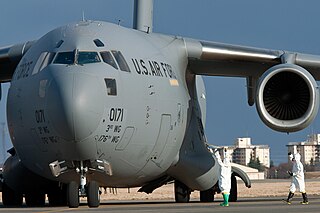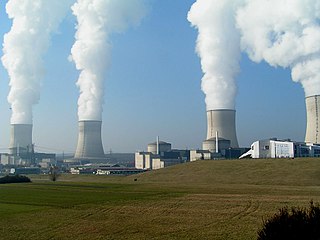Related Research Articles

The Federal Emergency Management Agency (FEMA) is an agency of the United States Department of Homeland Security (DHS), initially created under President Jimmy Carter by Presidential Reorganization Plan No. 3 of 1978 and implemented by two Executive Orders on April 1, 1979. The agency's primary purpose is to coordinate the response to a disaster that has occurred in the United States and that overwhelms the resources of local and state authorities. The governor of the state in which the disaster occurs must declare a state of emergency and formally request from the President that FEMA and the federal government respond to the disaster. The only exception to the state's gubernatorial declaration requirement occurs when an emergency or disaster takes place on federal property or to a federal asset—for example, the 1995 bombing of the Alfred P. Murrah Federal Building in Oklahoma City, Oklahoma, or the Space Shuttle Columbia in the 2003 return-flight disaster.

The Duane Arnold Energy Center (DAEC) was Iowa's only nuclear power plant. It is located on a 500-acre (200 ha) site on the west bank of the Cedar River, two miles (3.2 km) north-northeast of Palo, Iowa, USA, or eight miles (13 km) northwest of Cedar Rapids.

The Incident Command System (ICS) is a standardized approach to the command, control, and coordination of emergency response providing a common hierarchy within which responders from multiple agencies can be effective.

Emergency management or disaster management is the managerial function charged with creating the framework within which communities reduce vulnerability to hazards and cope with disasters. Emergency management, despite its name, does not actually focus on the management of emergencies, which can be understood as minor events with limited impacts and are managed through the day to day functions of a community. Instead, emergency management focuses on the management of disasters, which are events that produce more impacts than a community can handle on its own. The management of disasters tends to require some combination of activity from individuals and households, organizations, local, and/or higher levels of government. Although many different terminologies exist globally, the activities of emergency management can be generally categorized into preparedness, response, mitigation, and recovery, although other terms such as disaster risk reduction and prevention are also common. The outcome of emergency management is to prevent disasters and where this is not possible, to reduce their harmful impacts.
The National Response Plan (NRP) was a United States national plan to respond to emergencies such as natural disasters or terrorist attacks. It came into effect in December 2004, and was superseded by the National Response Framework on March 22, 2008.
The Massachusetts Emergency Management Agency (MEMA) is the agency of the Commonwealth of Massachusetts that coordinates federal, state, local, and private resources throughout the Commonwealth during times of disasters and emergencies.

The Armed Forces Radiobiology Research Institute (AFRRI) is an American triservice research laboratory in Bethesda, Maryland chartered by Congress in 1960 and formally established in 1961. It conducts research in the field of radiobiology and related matters which are essential to the operational and medical support of the U.S. Department of Defense (DoD) and the U.S. military services. AFRRI provides services and performs cooperative research with other federal and civilian agencies and institutions.

The Atomic Energy Regulatory Board (AERB) was constituted on 15 November 1983 by the President of India by exercising the powers conferred by Section 27 of the Atomic Energy Act, 1962 to carry out certain regulatory and safety functions under the Act. The regulatory authority of AERB is derived from the rules and notifications promulgated under the Atomic Energy Act, 1962 and the Environmental (Protection) Act, 1986. The headquarters is in Mumbai.

The United States’ Emergency Management Institute (EMI), of the United States Federal Emergency Management Agency (FEMA), serves as the United States’ focal point for the development and delivery of emergency management training. The emergency management training improves the capabilities of state, territorial, local, and tribal government officials; volunteer organizations; FEMA's disaster workforce; other Federal agencies; and the public and private sectors to minimize the impact of disasters and emergencies on the American public. EMI curricula are structured to meet the needs of this diverse audience, with an emphasis on separate organizations working together in all-hazards emergencies to save lives and protect property. Particular emphasis is placed on governing doctrine, such as, the National Response Framework (NRF), National Incident Management System (NIMS), and the National Preparedness Guidelines. EMI is fully accredited by the International Association for Continuing Education and Training (IACET) and the American Council on Education (ACE). The instruction is based upon the principles of Emergency Management and instructional systems design. This instruction creates a framework within whole community to reduce vulnerability to hazards and to cope with disasters. EMI develops courses and implements training delivery systems to include residential onsite training; offsite delivery in partnership with Emergency Management training systems, colleges, and universities; and technology-based mediums to conduct individual training courses for Emergency Management and Response personnel across the United States.
The National Nuclear Security Administration (NNSA) is a United States federal agency responsible for safeguarding national security through the military application of nuclear science. NNSA maintains and enhances the safety, security, and effectiveness of the U.S. nuclear weapons stockpile; works to reduce the global danger from weapons of mass destruction; provides the United States Navy with safe and effective nuclear propulsion; and responds to nuclear and radiological emergencies in the United States and abroad.
The California Governor's Office of Emergency Services is a California cabinet-level office responsible for overseeing and coordinating emergency preparedness, response, recovery and homeland security activities within the state. The agency was created by AB 38 (2008), superseding both the Office of Emergency Services (OES) and Office of Homeland Security (OHS).

A mass casualty incident describes an incident in which emergency medical services resources, such as personnel and equipment, are overwhelmed by the number and severity of casualties. For example, an incident where a two-person crew is responding to a motor vehicle collision with three severely injured people could be considered a mass casualty incident. The general public more commonly recognizes events such as building collapses, train and bus collisions, plane crashes, earthquakes and other large-scale emergencies as mass casualty incidents. Events such as the Oklahoma City bombing in 1995, the September 11 attacks in 2001, and the Boston Marathon bombing in 2013 are well-publicized examples of mass casualty incidents. The most common types of MCIs are generally caused by terrorism, mass-transportation accidents, fires or natural disasters. A multiple casualty incident is one in which there are multiple casualties. The key difference from a mass casualty incident is that in a multiple casualty incident the resources available are sufficient to manage the needs of the victims. The issue of resource availability is therefore critical to the understanding of these concepts. One crosses over from a multiple to a mass casualty incident when resources are exceeded and the systems are overwhelmed.
The Investigation Committee on the Accident at the Fukushima Nuclear Power Stations of Tokyo Electric Power Company was formed June 7, 2011 by the Japanese government as an independent body to investigate the March Fukushima Daiichi nuclear disaster. The Investigation Committee issued an interim report in December 2011, and issued its final report in July 2012.
Operations Plus WMD is a training level in dealing with hazardous materials.

National Response Scenario Number One is the United States federal government's planned response to a nuclear attack. It is one of the National Response Scenarios developed by the United States Department of Homeland Security, considered the most likely of fifteen emergency scenarios to impact the United States. The Scenarios are related to the National Response Framework (NRF), which describes the structures and mechanisms of a response and the National Incident Management System (NIMS) that gives a framework to orchestrate emergency management.

Nuclear Safety, Research, Demonstration, and Development Act of 1980, 42 U.S.C. § 9701, established nuclear safety policy for nuclear power plants supplying electric energy and electricity generation within the United States. The Act authorized a five-year demonstration program simulating conditions with light water nuclear reactors for the observation of control monitoring and phases of operation for nuclear reactor cores. The U.S. Department of Energy was authorized by the Act of Congress to conduct the nuclear reactor demonstration study while establishing a reactor engineering simulator facility at a United States national laboratory. The nuclear safety demonstration program was to provide research data regarding reactor design and simplification improvements given thermal power station simulations subjecting nuclear reactors to hypothesized calamity and customary operating conditions.

The Emergency Management (EM) career field is the United States Air Force's (USAF) primary organization responsible for implementing an installation-level EM program. Emergency Managers, also known by the Air Force Specialty Code (AFSC) 3E9X1, are the Air Force's subject matter experts for all non-medical Chemical, Biological, Radiological and Nuclear (CBRN) passive defense and consequence management matters.
During wartime operations, 3E9X1s are assigned to CBRN reconnaissance teams responsible for detecting, identifying, quantifying, and collecting CBRN material ensuring mission continuation and force survivability.
The National Domestic Preparedness Consortium (NDPC) is a training partner and established training arm of the U.S. Department of Homeland Security DHS/FEMA. It is a professional alliance of seven national institutions and organizations that work to develop and deliver training, technical assistance, plan assessments, and exercises to emergency responders and first receivers at the territories, state, local and tribal levels. The members were chosen for their unique knowledge bases in the areas of chemical, biological, radiological, nuclear, explosive, medical, critical infrastructure, and incident management, and have enhanced their core competencies at the request of DHS and FEMA to include other areas as well. The following is a list of the NDPC members and their core competencies:

Nuclear power plants pose high risk if chemicals are exposed to those in surrounding communities and areas. This nuclear emergency level classificationresponse system was firstly developed by the US Nuclear Regulatory Commission to allow effective and urgent responses to ultimately control and minimise any detrimental effects that nuclear chemicals can have. These classifications come in four different categories – Unusual Event, Alert, Site Area Emergency (SAE), as well as General Emergency. Thus, each classification has differing characteristics and purposes, depending on the situation at hand. Every nuclear power plant has a different emergency response action plan, also depending on its structure, location and nature. They were developed by thorough discussion and planning with numerous authoritative parties such as local, state, federal agencies as well as other private and non-profit groups that are in association with emergency services. Today, nuclear emergency plans are continuously being developed over time to be improved for future serious events to keep communities and nuclear power plant working members safe. There is a high emphasis for the need of these emergency responses in case of future events. Thus, nuclear plants can, and have paid up to approximately $78 million to ensure that are required measurements are readily available, and that equipment is sufficient and safe. This is applicable for all nuclear power plants in the United States of America.
The U.S. state of Washington has several emergency operations centers (EOCs).